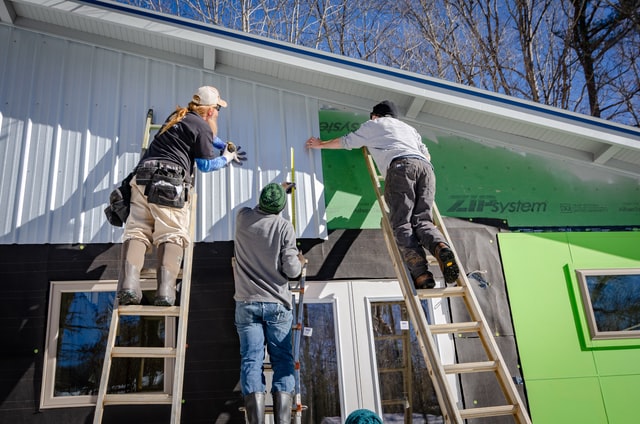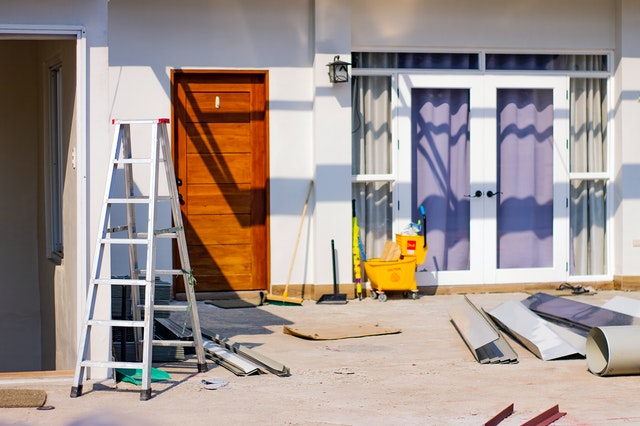Buliding Materials
This is an excerpt from the Book called “Tiny House Design & Construction Guide” by Dan Louche. Continue reading to learn more about Buliding Materials, thanks to the author.
A comprehensive materials list is essential
Having a comprehensive materials list can save a substantial amount of time and money. If a materials list was not provided with your plans or if you created your own design, you will want to take the time to come up with one before getting started. This can be done by mentally walking through each step of the construction process while examining the plans to count how much of each item or material will be required to complete each step. For instance, by examining the plans you can count the number of studs and sheets of plywood that will be needed. The problem with this approach is there are many items that could be overlooked if you do not have detailed knowledge of the build process. However, an incomplete list is still helpful as a starting point.
A material list allows you to purchase all of the required materials in as few trips to the store as possible. Not only will you spend less time going to and from the store, but you will also spend less time in the store. If a list is provided to one of the larger home improvement stores, they will ‘pull’ the order for you, saving you hours had you done it yourself. The down side to a store pulling an order is that the employees are not going to be as careful as you might be in their selection process, so you can expect to get a few items that may have been tossed aside by other shoppers. Even if you need to exchange a few items, this will require far less effort and time than gathering all the items yourself.

Many stores will provide special pricing for larger orders. In my experience, this discount has ranged from 90% on items like loose hardware down to 0% for items like tools. Typically, the overall discount will be about 10%. For a home requiring $12,000-16,000 in materials, this translates to significant savings. To get the discount, orders need to be placed at the office or counter reserved for professionals, sometimes called the Pro Desk. The orders must also be in excess of a minimum amount, usually around $2500. Because of this threshold it is important to maximize items and reduce the number of orders to benefit from the discounts available. If the store does not initially discount your order, you may need to ask them to send it to the ‘bid room’. This is a way of telling them to send your compiled list to the store’s corporate headquarters, where your discount will be calculated.
If you need to return some of the items in your order, reducing your order total below the discount threshold, the discount typically stays in place. So if necessary, you could pad your order by buying a few extra items to achieve the discount. I always recommend buying slightly more materials than you need anyways, as it can be frustrating getting some of your materials at 40% off, only to run out and have to buy more at full price in the store.
In order to avoid theft and weather damage with materials being stored outside, it is best to plan your orders in alignment with the stages of your tiny house project. You should divide your orders, while still making sure they are big enough to reach the price threshold for a discount. Place orders, while still making sure they are big enough to reach the price threshold for a discount. Place orders according to the sequence the materials will be used. By doing this, you will not have as many items laying around for extended periods of time.
If your materials are not stored inside, they will need to be covered by a tarp for protection. Be aware that moisture can build up under the tarp and result in mold growth. Mold can be easily removed from framing lumber, but will permanently stain and ruin expensive trim pieces. Trim is the most susceptible to damage, since it will be installed last and left outside the longest.
At the time of publishing this book, the big box retailers like Home Depot and Lowes also provide a special 10% discounts to veterans, with no minimum order required. Check with your local store for details on these and other discount options.
Below is a general list of materials that I often use when building tiny houses. If you are confused by some of the items, do not worry, they will be described in more detail in the later chapters. The quantities of each item will be determined by the design and size of the specific house being built, so that is not included here. Please consult your plan’s material list, if provided, for those details. The items are grouped by the departments in which they are generally found in stores.
BUILDING MATERIALS
2X LUMBER-2x (said “two-by”) lumber has a 2 as the first dimension (e.g. 2×4, 2×6, etc.). Most of the framing is built with 2×4’s. In conventional homes where trusses are not used, the rafters are usually 2×6 or larger. 2×4’s are adequate for the small span of most tiny houses. Only where significant load from snow is expected would larger lumber need to be used.
2xlumber also comes in varying lengths. Try to purchase lengths that will result in the least amount of waste. If you plans call for rafters that are 4 1/2 feet long, it is better to order a single 10 foot length than two 8 foot lengths. This will not only reduce waste, but will save you money.

A note on lumber in general: Always measure the lumber you are using and never trust the stated size. You will find that while some measurements are fairly consistently accurate, others can vary quite a bit. For instance, on multiple 2x4x96” pieces, their lengths will all be much more consistently6 accurate at 8 feet. You might be thinking that wood sold by the foot will not be as accurate to the stated size as wood sold by the inch. Plywood is sold by the foot, yet it is always very accurate. Confused yet? An easy solution is to measure everything. After a week or two you will learn what measurements to trust and which ones not to trust.
Another dimension of wood that you cannot always trust is its square-ness. Some wood is always very square (the corners are 990 degrees), like plywood, while other wood is notoriously not square, like siding. If you have wood that needs to be square, it is usually a good idea to run both ends through the saw. Again, a little experience will go a long way in knowing which boards will require this.
PLYWOOD – We strongly recommend plywood instead of oriented strand board (OSB). While plywood costs more, it is also more rigid, durable, and lighter than OSB. Additionally, when OSB gets wet it will swell up as it absorbs the water, but never returns to its original shape.
Plywood comes in 4 foot by 8 foot sheets of varying thicknesses and ply count. You will likely need two different thicknesses for your tiny house: 15/32 inch (often called ½ inch) for the walls and roof, and 23/32 inch (often called ¾ inch) tongue and groove (T&G) for the subfloor.
Note that tongue and groove sheets of plywood are 4 feet wide, but this includes the tongue that will overlap with any adjacent board’s grooves, so two sheets together will not equal a full 8 feet.
EXTERIOR SIDING AND TRIM – Cedar is light and holds up well against the weather, making it a great exterior siding for tiny houses. This is a product that is often heavily discounted at the pro desk, so if you plan to finish the exterior of the house before the store’s return period has elapsed, I suggest buying extra.
INTERIOR SIDING AND TRIM– Either slat paneling or sheet paneling is used for the interior siding because it is both lightweight and relatively durable. The types of trim include cove, casing, corner, and stop.
LOFT DECKING – For the loft decking, inexpensive plywood can be used. A more attractive alternative is 1×6 pine tongue and groove boards.
TAR PAPER– 30lb. tar paper is used for under the metal roof. 15 lb. tar paper can be used as an option for underlayment under wood flooring.
WATER & ICE SHIELD – This product serves a similar function as tar paper, except it is more durable and backed by adhesive. Its higher cost usually reserves it for roof valleys on conventional homes, but on tiny homes it can be used to cover the entire roof. If it is to be used under a metal roof, be sure to get the variant that is made for high heat.
STRAPPING – Strapping are metal pieces used to reinforce specific connections in a house.
FLASHING – Flashing is an impervious material used to prevent water from coming in contact with wood or from entering a wall cavity. There are various pieces of flashing that are used, including ‘Z’ flashing that is used above and below the window and door trim, 3 inch roof edge flashing that is used to cover the fenders, and roll valley flashing that is used to protect the underside of the subfloor.
The flashing that is used as part of the roof is covered in the roofing section.

NAIL PLATES – Nail plates are attached to the studs wherever wires or plumbing go through the studs. These prevent the wires or pipes from accidentally being pierced by a nail or brad.
MILLWORK
FRONT DOOR – Front doors are generally made out of wood, steel, or fiberglass. Be wary of plans that call for a narrower, custom sized front door because this will likely be the only way to get furniture and appliances in and out of your house. You may not want to be stuck with the same refrigerator for the next 25+ years.
POCKET DOOR AND FRAME – A pocket door is built inside the wall cavity so that it can be opened and closed without getting in the way. The frames come either pre-assembled or in a kit. If the door is to be stained be sure to select one made from solid wood.
WINDOWS – Windows can make up a very large portion of the material cost of your house (up to 20 percent). The come constructed of different materials ranging from less expensive vinyl to premium aluminum clad wood. Aluminum clad wood windows have wood on the interior that ca n be stained but still have an extremely durable exterior that comes in a variety of colors. Vinyl windows are less expensive but not nearly as durable. They are also not available in all areas and generally only come in white.
SHIMS – Shims are tapered pieces of wood that are used while installing the windows and doors.
ELECTRICAL
LIGHTING – The lighting that is needed for the house will likely include a bathroom fan/light combo, a light over the shower, lighting for under the loft (recessed can lights), lighting for any open areas (ceiling fan/light combo), and any exterior lighting.
OUTLET BOXES – Outlet boxes are nailed directly to the studs and hold the switches and outlets. These come in different sizes depending on the number of outlets and switches (called ‘gang’) they will contain (e.g. 1 gang, etc.). These are also divided into ‘new work’ and ‘old work’. For a new house you will choose ‘new work’.
OUTLETS AND SWITCHES – Outlets and switches can normally be purchased in ‘contractor packs’ (10 per pack) to get a discount. Special switches (called 3-way switches) are required if you plan to operate a single light from two different switches.
SWITCH PLATES – Switch plates are installed on the outlet boxes to cover the switches and outlets.
WIRE– Residential sheathed wiring is run through the walls and provides power to the lights and outlets.
WIRE STAPLES – Wire staples are heavy duty staples that are installed with a hammer and hold the interior wiring against the studs. These are often used on the wires right before they enter an outlet box, in order to keep them in place.
ELECTRICAL PANEL AND BREAKERS – The electrical panel or breaker box will hold the breakers for the house’s electrical system.
CABLE, NETWORK AND TELEPHONE WIRES – Any additional wires that you would like in the house will need to be purchased as well. It is best o install these cables away from the electrical wires as they can cause interference.
FLOORING
HARDWOOD FLOORING – Hardwood flooring is typically used throughout the house, with the exception of the bathroom.
VINYL TILES – Vinyl tiles can be attractive, lightweight, easy to install, and durable. These are a great option for the bathroom.
VINYL ADHESIVE – Vinyl tiles usually come with an adhesive pre-applied to the back of them, but an additional layer is recommended.
FLOORING TRANSITION PIECE – The flooring transition piece covers the transition between different flooring types and thicknesses.
HARDWARE
EXTERIOR SCREWS – Exterior screws are used to attach the sheathing and are an alternative to using nails for the framing.
WAFER HEAD SCREWS – Wafer head screws have a low profile head. These are used to attach the strapping to the framing, since they are less likely to interfere with the interior siding.

BOLTS, NUTS, AND WASHERS – Bolts are used to attach the subfloor to the trailer.
EXTERIOR NAILS – Spiral shank exterior nails are used to attach the exterior siding.
PLASTICAP OR SIMPLEX NAILS – Plasticap or simplex nails have a large, flat plastic head. These are used to attach thin, less durable items like tar paper to the roof, or in some cases the house wrap.
STAPLES – Standard T50 staples are used to attach the metal valley flashing to the trailer before the subfloor is constructed. These do not have to be that strong since the subfloor will keep the flashing in place.
BRADS – Brads are small nails that have a very small head. They are often used on finishing products, where a visible nail head is undesired, like the interior siding.
DOOR HARDWARE – Door hardware is required for both the front door and the interior door.
INSULATION
EXTRUDED POLYSTYRENE (STYROFOAM) BOARDS – Styrofoam boards are used to insulate the subfloor and possibly the wall and roof cavities.
SPRAY FOAM – Several cans of aerosol spray foam will be needed to fill the cracks around the fenders, windows, and doors. This product comes in several varieties, based on how much it will expand. Minimally expansive foam is used around the windows and doors to avoid bending the jambs, preventing the windows or doors from operating correctly. Significantly more of these canisters will be needed if Styrofoam boards will be used for the interior insulation. In this case, I recommend finding a version, like that made by Hilti, which includes a rigid dispenser that will allow for one handed operation.
HOUSEWRAP AND TAPE – Housewrap creates both a moisture and air barrier around a house. Not all housewraps are created equal. I strongly recommend DuPontTM Tyvek. A special tape is also required to seal any seams in the housewrap.
PAINT
PAINTS AND STAINS – Paints or stains are used for the exterior siding, the interior siding, and the front door.
CONSTRUCTION ADHESIVE – Construction adhesive, sometime referred to by the brand name Liquid Nails, is used when installing the sheathing and interior siding.
PLUMBING
FIBERGLASS SHOWER – Several different materials can be used to make a shower stall. A popular option is a one piece, 36 inch fiberglass shower. Due to its size, the shower needs to be put in the house before all of the exterior walls are stood up. These showers also come in kits that can be installed later, but they are generally flimsy and more difficult for the homeowner to clean because of the seams.
CPVC PIPES, FITTINGS AND PRIMER/CEMENT – CPVC pipes and fitting are used for the plumbing supply lines.
PVC PIPES, FITTINGS AND PRIMER/CEMENT – PVC pipes and fittings are used for the plumbing drain lines.
KITCHEN SINK AND FAUCET – A narrow, single well sink should be selected to preserve counter space. If a larger sink is used, a cutting board can be used to cover it up to temporarily regain some counter space.
SHOWER ASSEMBLY – The shower assembly includes the shower head and the controls for the water pressure and temperature.
TOILET – The available utilities at the location where you plan to park your house will determine the type of toilet you need. Popular options include a standard flushable toilet and a composting toilet.
WATER HEATER – For a tiny house, a tankless water heater is optimal. They have a smaller size and provide endless hot water. While there are several inexpensive options available, if your house will be located in an area that will often have cold weather, be sure to choose a heater that is or can be insulated.
DRYER VENT –A dryer vent is used for the bathroom fan and also to cover up the air inlet for the plumbing.
HANGER TAPE ROLL – Hanger tape is galvanized strips of metal used to add support to hanging pipes.
TRAILER SUPPLIER
TRAILER – The trailer is the foundation of a house on wheels.
JACK STANDS – Jack stands are used to level the house during construction and to keep the house stable while it is lived in.
METAL ROOF
The metal roofing will likely need to be custom ordered, as retailer’s generally only carry basic parts that are more suitable for sheds. Metal roofing is made up of several different components. The complexity of your roofs design will dictate how many components you will need to order.


